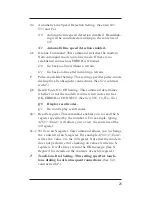
15
5. Using AT Commands
Communications programs control your modem by issuing
modem instructions called AT commands. While it is usually
easiest to let the communication software handle the task of
issuing AT commands, there may be occasions when you will
want to control a series of commands yourself. The information
that follows is included to allow you to tailor your modem for
specific needs.
If you want to send AT commands to your modem directly, you
must be running a data communication program. (You cannot
send AT commands from your operating system prompt.) Once
the communication program is started, you must put it into
terminal mode. Many programs do this automatically. Your
modem must also be in command mode (see Some Notes About
AT Commands) to accept AT command strings. To verify whether
your modem is in the proper mode, type AT <Enter>. If the
modem responds with an OK message, you are all set.
AT commands must:
1.
Start with the command string AT
2.
Contain one or more of the commands listed in this
chapter
3.
End with a carriage return (shown in this book as
<Enter>).
The following notation conventions are used in this chapter:
• AT commands and messages are shown in italics, like so:
AT &F0 <Enter>.
• Factory default settings for commands are shown in bold.
These settings are in effect until you issue a command
altering the setting. For instance, the default setting for Bn
is B1. To return the modem to its factory default settings at
any time, type AT &F0 <Enter>.
• S-registers affected by, or related to, particular AT com-
mands are listed in brackets at the end of the command
Summary of Contents for STI-FAX/28.8
Page 3: ...iii 28 8 Communicator V 34 Data Fax Modem Plug n Play PC Card User Guide ...
Page 12: ...xii Notes ...
Page 24: ...12 Notes ...
Page 54: ...42 Notes ...
Page 56: ...44 Notes ...
















































